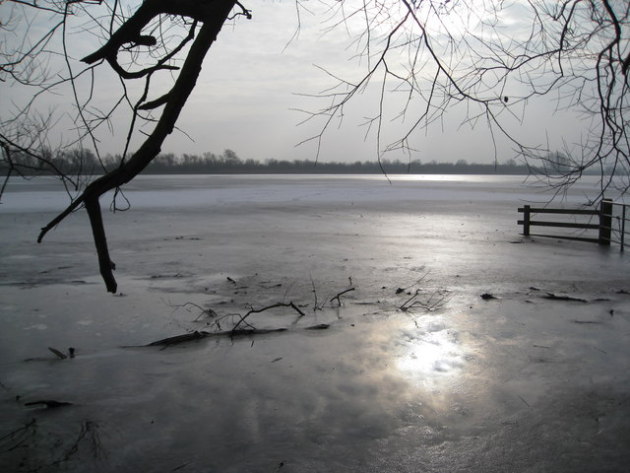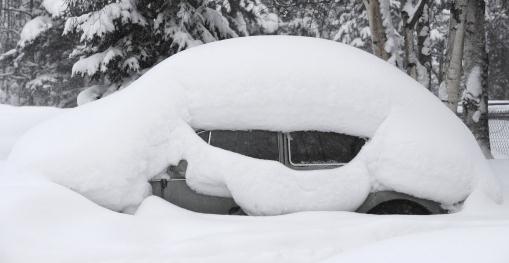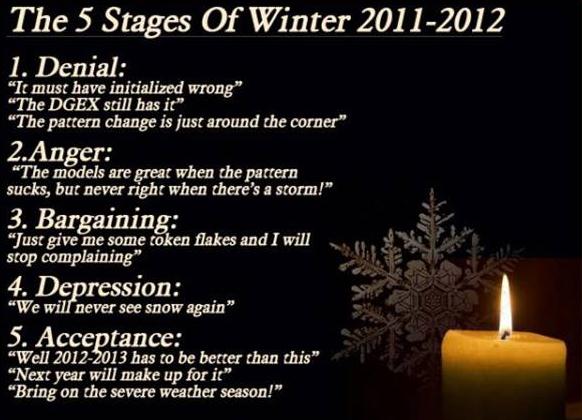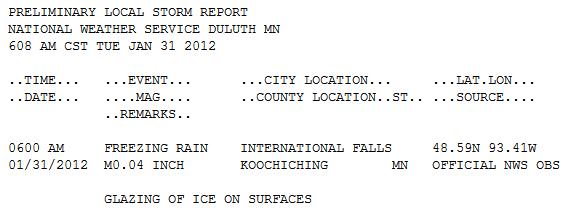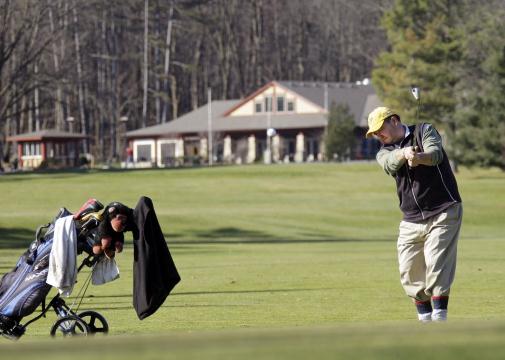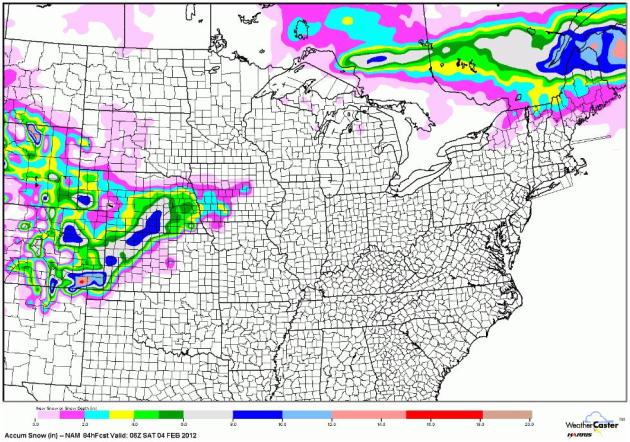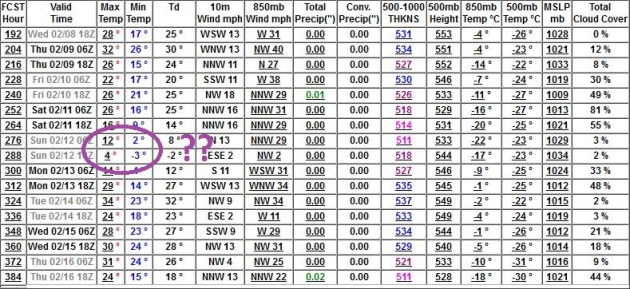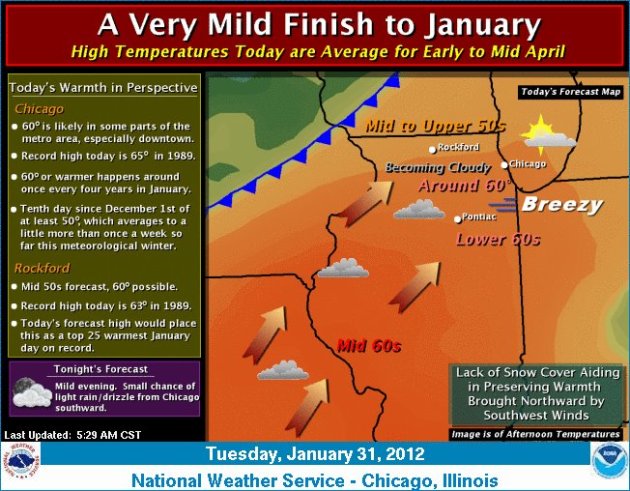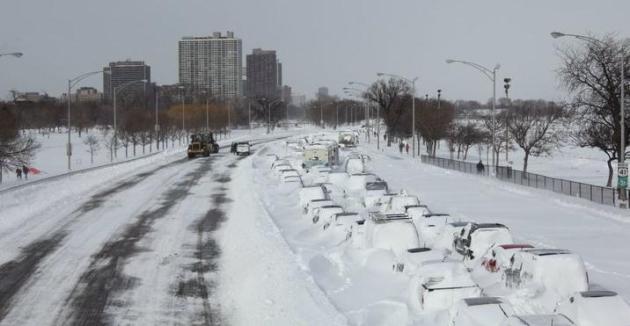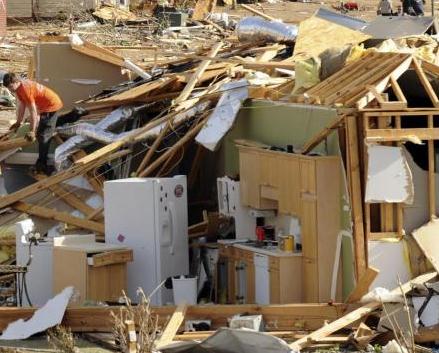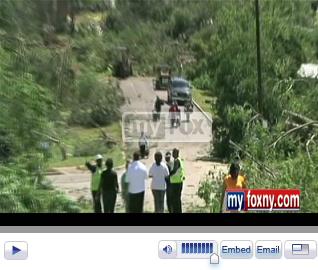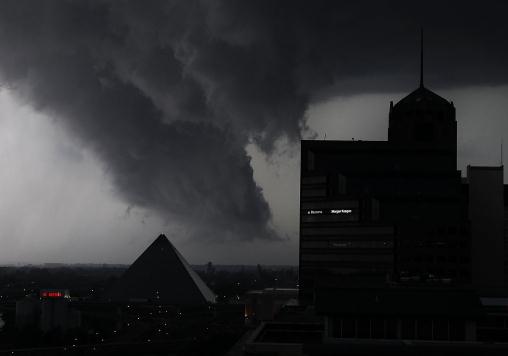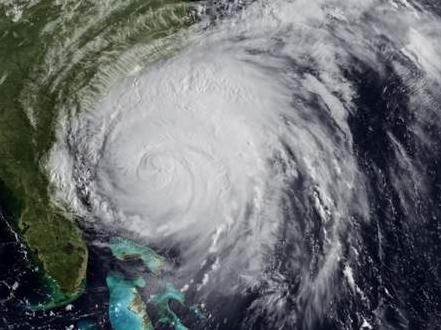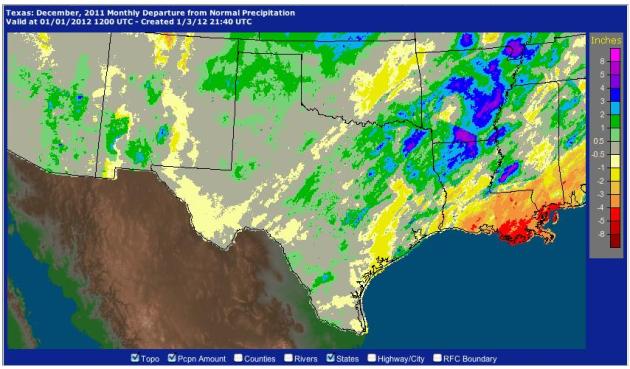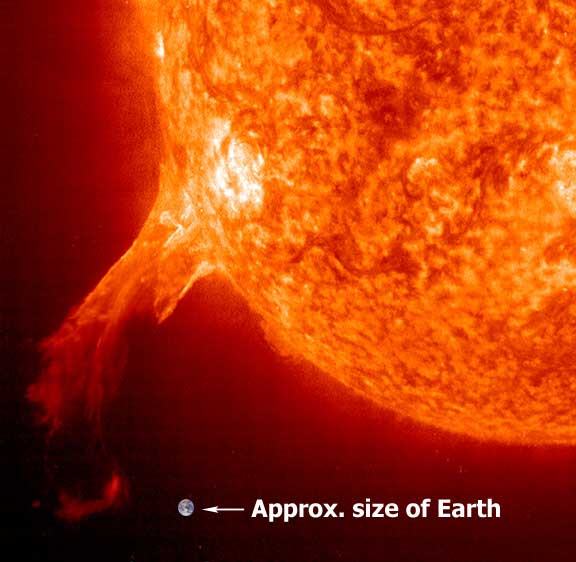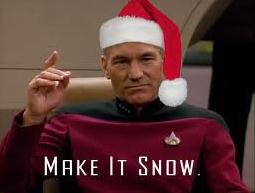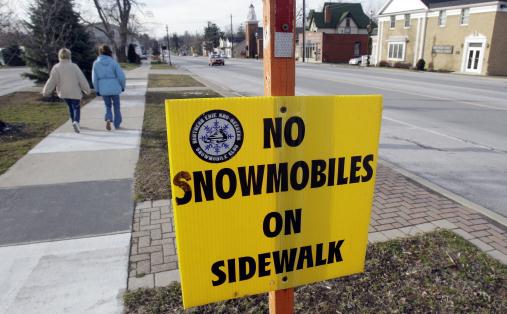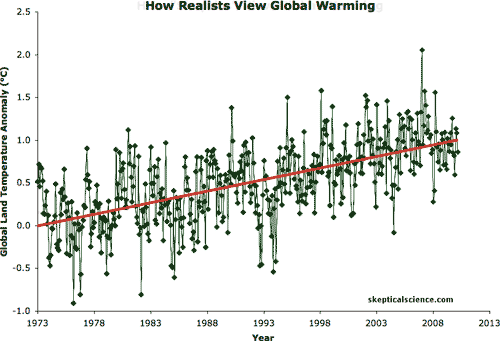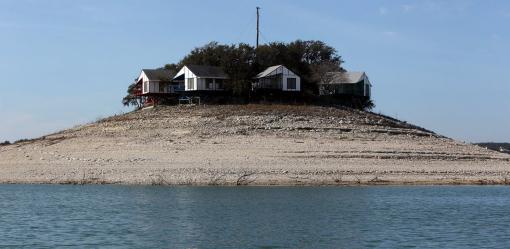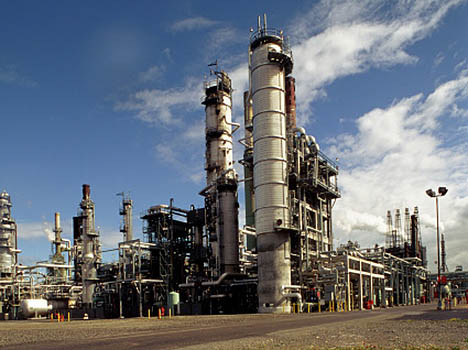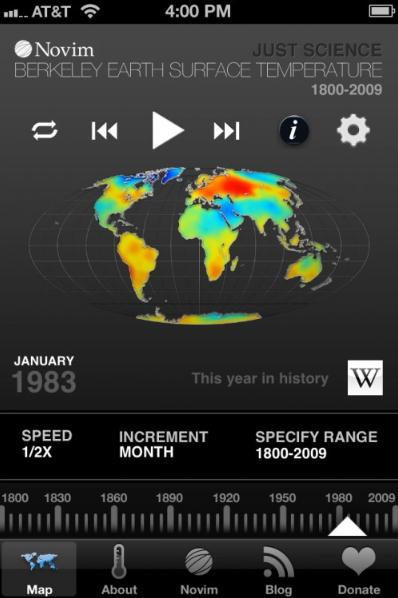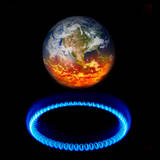66 F. high at Washington Dulles Airport on Tuesday, a new record for January 31.
55 F. high at Islip, New York, a new record.
63 F. record high reported at Georgetown, Delaware
32.5" of lake-effect snow at Fulton, New York (10 miles from the Lake Ontario shoreline) since Monday.
-65 F. reported at Galena, Alaska, in the state's bitter interior, last Saturday morning. The old record was -56 in 1947.
Meteorological Denial. It's (almost) time to write off this winter. True, we can get dumped on in late February and March, but late winter snowfalls tend to only stick around a few days - the sun is too high in the sky for snow to linger on the ground for long. Thanks to twitpic, and my buddy Mike Seidel at The Weather Channel, for forwarding this one along. How true.
Rain At International Falls on January 31? The odds of rain that far north on the last day of January are slim to nil. And that rain froze (on contact) with cold surfaces, producing a thin glaze of ice. More reports from NOAA
here.
One Week's Worth Of Weather Records. Thanks to Ham Weather and NOAA for reminding us how unusual the warmth has been across the USA. Green dots display record 24 hour rainfall amounts, red dots are record highs, yellow dots record (warm) nighttime lows. An interactive map is
here, courtesy of those rocket scientist/weather geeks over at Ham Weather.
 Winter On Hold
Winter On Hold. Unseasonable, almost April-like warmth blanketed most of America yesterday. Here's more from NOAA's
Environmental Visualization Laboratory: "
On the last day of January, many people throughout the U.S. are enjoying unusually warm temperatures. Shown in this image, using data from today's NOAA Rapid Update Cycle model, are the high temperatures across the U.S. Many areas are experiencing temperatures well above 50 or 60 degrees Fahrenheit, even in far northern locales. "
In Search Of Snow. According to NOAA's
National Snow Analysis, only 23.3% of the Lower 48 States have snow on the ground. A few interesting stats:
2012: 23.3%
2011: 41.6%
2010: 70%
2006: 21.6%
* 2006 is the only year I could find in the last 30 years that had less snow on the ground than we're seeing in 2012.
One Big Silver Lining: A Vastly Reduced Risk of Spring Flooding. Who knows what will happen between now and March (although I suspect it's best to go with "persistence", which is meteorological slang for go with the flow, acknowledge the trends). The drought that plagued Texas last year (worst in state history, including the Dust Bowl years of the mid 1930s) is expanding north, through a combination of La Nina, persistent blocking patterns, and other factors we may not even be aware of. Unless we see a series of massive snowstorms in late February and March the risk of severe flooding across the Upper Midwest will be considerably lower than recent years. According to NOAA's "Snow Water Equivalent" map above there's only .04 to 1" of liquid water trapped in the (meager) snow pack from the eastern Dakotas into Minnesota, about 2-4" water over northern Wisconsin and the U.P. of Michigan, where lake effect has cheered snow lovers.
It's Been A Warm Winter, But Warmest? I think it would be safe to say that we are experiencing the warmest winter since 2006, probably a Top 5 or Top 10 warmest winter for the lower 48 states.
MSNBC.com has an article focusing on just how unusual this almost unprecedented spring fling really is: "
How soon we forget. Sure, this last month has been warmer than average across the lower 48 states, but the record for warmest January was set just six years ago in January 2006 and it's too soon to tell if that will fall. Deke Arndt, chief of the National Climatic Data Center's monitoring service, told msnbc.com that he can't rule out a record. "It's too early for us to call shots" on just where January 2012 will end up, he said, "but it has been quite warm so far and we expect it to finish in the top 15 or 20," based on records dating back to 1895. The official report for January comes out on Feb. 7, he added."
Photo credit above: "
Doug Csongei chips to the first green at Big Met golf course in Fairview Park, Ohio Tuesday, Jan. 31, 2012. Ohio is in the thick of an unusual winter that has brought the state warm temperatures and little snow, with the long-range forecast calling for more winter warmth. (AP Photo/Mark Duncan)."
Warm Winter Adds To Retailers Post-Holiday Blues.
Reuters has the details: "
Unseasonably warm weather across the United States forced many retailers to offer deeper-than-usual discounts to clear out coats, sweaters and boots in January, pointing to tepid sales in the typically slow post-holiday month. Analysts expect U.S. retailers to report a 2 percent rise in January same-store sales, compared with a year-earlier increase of 4.4 percent, according to Thomson Reuters data. "In this economy, nobody is going to buy unless there is a need for it, and the weather says, 'You don't need it,'" said Scott Bernhardt, chief operating officer of Planalytics, which provides weather data for businesses."
Photo credit above: "
Runners in warm weather gear pass by a sign, marketing warm winter accessories, located outside The Museum Store in the 200 block of William Street in downtown Fredericksburg, Va. on Friday afternoon, Jan. 27, 2012. The store is part of the Area Museum and Cultural Center. (AP Photo/The Free Lance-Star, Robert A. Martin)."
One Place Where Winter Is Alive And Well. The town of Fulton, New York, just 10 miles from the Lake Ontario shoreline, has seen plenty of (lake effect) snow in recent weeks. That's what you have to do to insure snow these days - situation yourself 10-30 miles downwind of one of the Great Lakes. "
Chris Wolford digs out the driveway of her South 7th Street home, Monday, Jan. 30, 2012, in Fulton, N.Y. Over 30 inches of snow fell in Fulton during the area's first lake-effect storm of the season. (AP Photo/The Post-Standard, Michelle Gable)."
Ski Nebraska. The latest GFS model is printing out some 6-8" snowfall amounts for western Kansas and central Nebraska later this week as a slow-moving storm pushes north across the Plains, weakening before passing south of Minnesota. The Great Snow Drought of 2012 limps on.
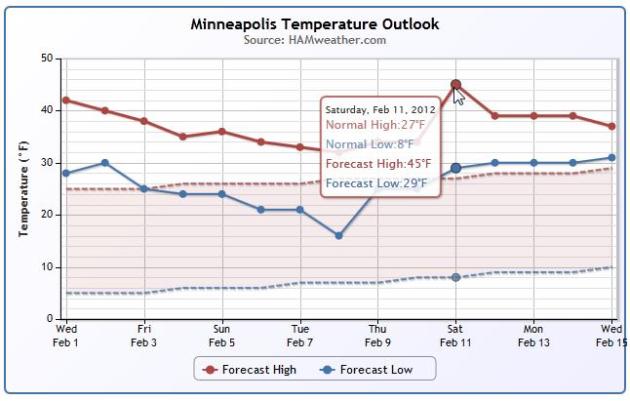 Trending Well Above Average
Trending Well Above Average. Although the GFS is hinting at a significant (but brief)
cool-down in mid February, the models are all highly erratic. As you can see, temperatures are forecast to trend well above average levels (in dashes) through February 14 or so. Graph courtesy of
Ham Weather. Plug in your local zip code to get a personalized extended outlook for home.
One More Subzero Night? My faith in the GFS model has dwindled considerably; I've seen some wild swings in recent runs, so my confidence level is low. The latest run shows a fleeting cold snap around February 12, with one night below zero. That may change again later today, but there's little doubt we'll see a few more beefy cold fronts in the weeks to come.
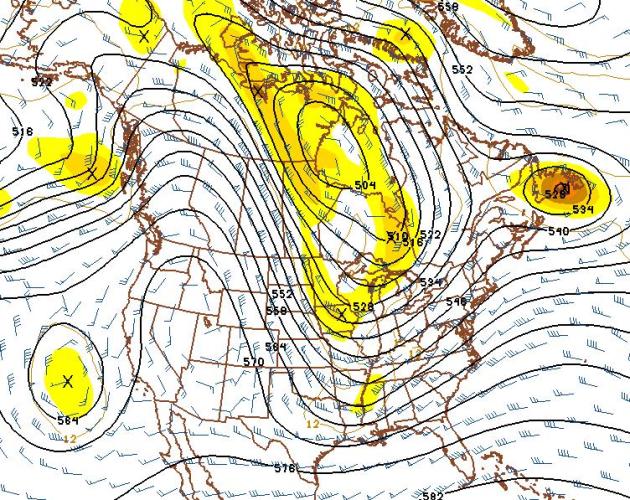 Don't Write Winter Off Just Yet
Don't Write Winter Off Just Yet. Although temperatures will probably trend well above average through mid February, there will be cold fronts. The 500 mb outlook above (GFS) is valid February 16. Disclaimer:
jet stream winds are blowing much faster than usual, even for this of year, when wind speeds peak. That makes the pattern unstable, and a long range forecast much more difficult. Models have been highly erratic, but (if) this forecast verifies we could expect another spell of single digits and teens for highs, and subzero nights around Feb. 17-18. We'll see.
 Another Close Call.
Another Close Call. This is a 5-day precipitation forecast from NOAA. For the last few months Minnesota, the Dakotas and much of Wisconsin have been in something of a meteorological no-man's land. Big sloppy storms detouring south, a family of clippers sailing off to our north, with very little snow (or rain) close to home. The QPF (quantitative precipitation forecast) prints out some very heavy amounts of rain and snow for the central Plains, but the weekend storm should pass just south of Minnesota....again.
70 tornadoes across the USA in January - 3rd highest tornado count since accurate tornado records were first kept in 1950. Source: SPC. More details from USA Today below.
January Tornadoes Across America:
212: 1999
84: 2008
70: 2012
Photo credit above: "
The roof is missing over this classroom at Center Point Elementary School in Center Point, Ala., Tuesday, Jan. 24, 2012. A series of tornadoes struck Alabama Monday (Jan. 23), killing two people and destroying over 400 homes. (AP Photo/Dave Martin)."
37 years. Global January - December temperatures have been above the long-term (1951-1980) average since 1974, according to
NASA.
215 months. The last time a specific month was colder than the 1951-1980 average was February, 1994. (NASA).
"
Climate change “skeptics”. Every scientist I know is a “skeptic”. It’s the way science works. You observe, question, seek answers, test, form ideas, sure argue about results of experiments and conclusions and sometimes your ideas or results are shown to be incorrect. So what? We should all be skeptics. We should all seek more information and knowledge and not be drawn, or seek out only to those who agree with our ideas, be they science, political, whatever. Let’s drop the lightning rod labels above being thrown from opposite sides of the river of knowledge and understanding." - from a timely post from WJLA-TV's Bob Ryan about the controversial "Forecast The Facts" campaign to expose climate skeptics among the nation's TV meteorologists. Details below.
"June-uary" In Chicago. 60s on the last day of January in the Windy City? One year ago Chicago was bracing for a blizzard, one that dropped 1-2 feet of snow, paralyzing the city with 4-5 foot drifts and impassable streets. That old adage, what a difference a year makes, rings true. Map courtesy of the Chicago office of the National Weather Service.
Groundhog Day 2011. On February 1-2, 2011, Chicago was hit by a massive winter storm, one that shut down the city. Photo of Lakeshore Drive courtesy of Mike Tannura.
Experts Offer Drivers Advice On Winter Travel. Pittsburghlive.com's "
TribLive News" has some timely advice. One of these days we may even be able to put these suggestions to good use: "
You need to make sure your headlights and taillights aren't covered because they obviously wouldn't be as vibrant not only for you to see, but for other drivers to see you," she said. "You also have to make sure your hood and roof are clear so no chunks of snow or ice can fall off." If you don't, it isn't just dangerous -- it's illegal. In Pennsylvania, you can be ticketed if any material falls from your vehicle and strikes another. Once you're on the road -- with your seat belt on, of course -- Stanley said the key is to remain calm and steady. "When you're driving (on ice or snow-covered roads), you want to avoid making any quick movements," he said. "You don't want to hit the brake hard, punch the gas or turn the steering wheel too quickly. Those are easy ways to lose control. You also need to put more space between you and the car in front of you. If you're following too closely and need to stop suddenly, it's obviously going to be much more difficult to do on ice."
Severe (Winter) Weather Preparedness.
Lawn and Landscape has a good checklist to keep in mind when the next major winter snow/ice storm approaches. And it will. Right? "
The equipment checklist can help assess preparedness for an unexpected weather event or other emergency – and offers some safety tips:
- Pole saws or pruners can help clear away dead or damaged limbs near your home or building or on your driveway. Make sure you always keep a firm footing on the ground when using such equipment. Do not use a ladder, and stay away from electrical conductors.
- A chain saw can help clear away trees and more massive limbs, but first read and understand the instruction manual and ensure equipment is in good condition. Do not work around power lines, since they can be the biggest threat to safety.
- Power generators can keep the lights on, refrigerators running and water flowing in an emergency. Do not operate power generators, however, in enclosed areas. Carbon monoxide is a colorless, odorless gas that can become concentrated in enclosed areas and cause serious injury or death."
2012 Off To A Furious Start In Tornadoes.
USA Today has the latest statistics: "
January has been an unusually violent month for tornadoes in the USA: 70 twisters have been reported. And more could be on the way.
The total this month is the third-highest in January since accurate tornado records began in 1950, said Greg Carbin, warning coordination meteorologist with the Storm Prediction Center in Norman, Okla. Since 1950, only January 1999 (with 212) and January 2008 (with 84) saw more tornadoes. The twisters killed two people this month, both in Alabama. The last time there were tornado-related deaths in January was in 2008, when seven people died, Carbin said. The deadliest January on record was in 1969, when 32 people were killed by tornadoes." Photo courtesy of Hal Yeager, AP.
Alabama Was Most Tornado-Prone State In 2011.
My Fox New York has the story: "
MONTGOMERY, Ala. - In 2011, 177 tornadoes struck Alabama, making it the state with the highest number of twisters in a year that the South was hit particularly hard by violent storms, according to the National Weather Service. Mississippi was right behind Alabama in second place with 169 tornadoes and North Carolina was fourth with 113. Although tornado season has not quite started yet for most of the country, Alabama is already ranked in the top spot for 2012, with 22 tornado strikes since New Year's Day."
Tornado Myths Tough For Forecasters To Bust.
Yahoo News has an interesting article: "
NEW ORLEANS — Even after a tornado warning was issued for Cordova, Ala., during last April's deadly event, one man — we'll call him Bill — still wasn't concerned. The tornado was miles away and Walker County, where Cordova is located, is a big county. Besides, he lives on a hill and everyone knows that tornadoes can't come up a hill. And his motorcycle in the driveway really needed fixing. Then a twister rating EF-3 on the tornado-damage scale roared through town, narrowly missing Bill's house. "It was out of character for everything that I've ever known about tornadoes," Bill told researchers in an interview after the storm. His real name was not used to protect his anonymity." Photo above courtesy of the AP.
Designing A Better System To Warn About Hurricanes.
The Herald Tribune has more details: "
NEW ORLEANS - Hurricane forecasting is changing — and not just on the meteorology side. The National Hurricane Center is working on new ways to tell people how they are at risk when hurricanes threaten. As part of the federal Hurricane Forecast Improvement Project, psychologists are trying to figure out how to issue storm warnings that the public and emergency managers can use to make fast decisions about whether to evacuate or stay put. After years of effort by hurricane officials to teach people about storm surge, many still do not understand. They also misinterpret other forecast products, such as the "cone of uncertainty," which shows where a hurricane is likely to travel."
Drought May Cause Shut-Down Of Texas Rice Production.
Climate Central has an update: "
Although recent rains have put a dent in the Texas drought, a day of reckoning looms for the state’s long-grain rice growers, who pump millions into the economy in Southeast Texas each year and account for about 5 percent of America’s rice production. Come March 1, if there is less than 850,000 acre-feet of water in reservoirs along the Lower Colorado River, water managers will be forced to take the unprecedented step of withholding water from agricultural users, which will mean severe cuts to Texas rice production this year."
NOAA Satellites Aid In The Rescue Of 207 People In 2011. NOAA has the story: "
In 2011, NOAA satellites were critical in the rescues of 207 people from life-threatening situations throughout the United States and its surrounding waters. The satellites picked up distress signals from emergency beacons carried by downed pilots, shipwrecked boaters and stranded hikers, and relayed the information about their location to first responders on the ground. NOAA’s polar-orbiting and geostationary satellites are part of the international Search and Rescue Satellite Aided Tracking System, called COSPAS-SARSAT. This system uses a network of satellites to quickly detect and locate distress signals from emergency beacons onboard aircraft and boats, and from smaller, handheld personal locator beacons called PLBs." Image above courtesy of NOAA.
NASA Enhances Solar Storm Forecasting.
Informationweek.com has the story: "
The use of the computational predictive technique couldn't come as a better time, as the sun is entering its solar maximum, or period of greatest activity, which will spur an increase in space weather, according to the agency. NASA is applying existing technology called "ensemble forecasting" that's been used to predict hurricanes in its observations of solar weather to better predict the path and effect of solar storms. Researchers at the Space Weather Laboratory of Goddard Space Flight Research Center have begun to implement ensemble forecasting--which allows them to produce as many as 100 computerized forecasts at once--with full implementation in three years' time, according to NASA." Photo above courtesy of NASA.
Tracking Storms On The Sun. Click
here to see the latest data on our nearest and dearest star, the sun. Or should I say The Sun. Data courtesy of NOAA's Space Weather Prediction Center.
 Is Meteorology Turning Into Computer Science?
Is Meteorology Turning Into Computer Science? Here's an intriguing blog from meteorologist AJ Jain's blog, "
Fresh AJ". From personal experience I can tell you that we're always on the lookout for meteorologists who can either a). present the weather professionally on-camera, or b). use computer skills to help us develop new software for visualization, the energy markets, and creating more accurate, hyper-local forecasts: "
After attending the student conference at the AMS career fair, I spoke to each private employer that was hiring meteorologists. Some of the employers I spoke to at the booths were, “Unisys, Climate Corporation, Wunderground, Accuweather, Impact weather, among others. And here’s what was very intriguing: a majority of these employers are looking for meteorology developers (ie people who are excellent at programming but also understand meteorology). Meteorology programmers are a growing trend in today’s meteorology job world. Whether it is programming using Python, C++, Objective C, or PHP, the “new” graduate in meteorology in today’s economic climate should probably have these skills under their belt. When I spoke to a few of them…they mentioned if someone is a MS or PHD with programming skills, they would like to talk with them. Some of them even mentioned they were prepared to throw ridiculous amounts of cash if you met those qualifications…so if you’re interested in learning more, let me know!"
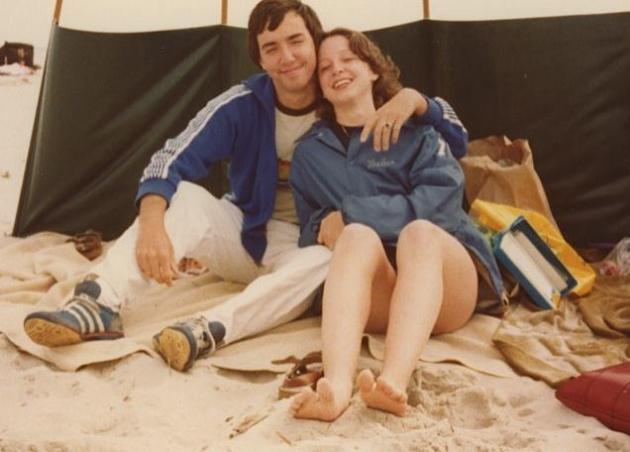 Open Your Eyes Paul
Open Your Eyes Paul. That was me, back in 1979, when I was a senior at Penn State. Pretty natural in front of the camera, huh? My wife has aged far more gracefully than I have. Getting old sucks.
Pinch Me
I just woke up from the most amazing daydream. It was late January, yet the grill was sizzling away, my boys tossing the football in the back yard, neighbors stopping by to ask "Hey Paul, is it MILD enough 'fer 'ya?"
Dickens had it right: this winter has been the best of times - and the worst of times. It's been a Godsend for seniors, who don't have to worry quite as much about slipping on ice. We've saved almost 20% on heating bills since Autumn. Fewer fender benders, more money for cities to pave potholes vs. clearing snow. But for anyone making a living from snow and cold our alleged "winter" has been an unmitigated disaster. Sales of winter essentials (and toys) are down 30-50%
Meanwhile baffled meteorologists scan the maps, wondering if when this record-setting Pacific breeze will finally shut off. The answer: no time soon. The European ECMWF model brings puffs of chilly air south of the border, but I don't see anything subzero. For the record we've had 3 subzero nights so far this winter in the Twin Cities. A typical winter brings 28 nights of negative numbers.
Nebraska picks up a foot of snow; but a weekend storm spins south of Minnesota. Again. Trending considerably milder than average through mid February with more 30s, even a few 40s? Yep. The Year Without A (real) Winter? It sure looks that way. Watch - we'll get dumped on in late April. Yes, that would be fitting.
Weather, Climate, And "Facts". Here's an excerpt of a
timely post from a meteorologist I have a tremendous amount of respect for, Bob Ryan at WJLA-TV in Washington D.C. "
First the FACTS about what happened at the annual meeting of the American Meteorological Society last week. Full disclosure I have been a Member (and elected Fellow) and active participant of the AMS in many boards, commissioner and past president since my student member days of about 45 years ago. The AMS is the largest scientific and professional society of its type in the world. The governing body of the AMS is the Council of the Society, most of whose members and AMS president are elected by the 14,000 individuals members of the Society. An open, democratic process. The various statements of the Society cover areas of science NOT politics and policy varying from science education to mobile homes to water resources, weather forecasts and yes climate change. The FACT is that every scientific based statement of the AMS is reviewed at a minimum every 5 years....Since about the 1700s burning of fossil fuels has released about ½ trillion tons of carbon into the atmosphere . . . 500, 000, 0000 tons and the concentration of CO2 has increased today by almost 40% from 300 years ago. Solid science and solid observations or a “hoax”?"
 Chicago's Warm Winter Weather And Global Warming
Chicago's Warm Winter Weather And Global Warming. The story from Whet Moser over at
Chicagomag.com. Here's an excerpt: "
The last time I wrote about Chicago's warm winter (and what it might have to do with SPACE WEATHER), someone asked me on Facebook whether it had anything to do with global warming. The best I could do was basically "that's not exactly how to think about it":
I think the best way to think of it is a baseball metaphor (sorry, that's how my mind works): month-to-month, year-to-year weather is like how many runs are scored from game to game; climate change is like the steroid era or lowering the mound, which adjust things across the board. Like, if you lower the mound, you're going to get *more* 20-run games, but you're still going to get shutouts, just not as many.
So I was kind of pleased with myself to see one of my favorite weather bloggers, Dr. Jeff Masters, use a nearly identical metaphor the other day: The natural weather rhythms I've grown to used to during my 30 years as a meteorologist have become significantly disrupted over the past few years. Many of Earth's major atmospheric circulation patterns have seen significant shifts and unprecedented behavior; new patterns that were unknown have emerged, and extreme weather events were incredibly intense and numerous during 2010 - 2011."
Perception = Reality. From a post at
Think Progress: "In line with projections by climate scientists, the 2000s were significantly hotter than the 1990s, which were hotter than the 1980s, reflecting the steady rise in carbon dioxide emissions. This consistent increase in average temperature is partially masked by natural variability on short time spans. Johnson’s nonsensical claim rests on that deliberate misinterpretation of temperature data, as this infographic from Skeptical Science (above) shows."
Think We're Headed For A New Ice Age? You're Wrong. The story from
gizmodo.com: "
Read some reports of our changing climate today, and you might be convinced that we're about to enter a mini Ice Age, with decades of plummeting temperatures ahead. Here's why that's a lot of hot air. Today, the Daily Mail report that we are "heading for a mini ice age to rival the 70-year temperature drop that saw frost fairs held on the Thames [in London, UK] in the 17th Century." They cite a report by the Meteorological Office and the University of East Anglia Climatic Research Unit about solar cycles. Currently, we should be at a maximum in the solar cycle—Cycle 24, in fact—experiencing the most heat the sun can thrown at us. For some reason, we're not: the sun has been a little erratic in the past few years." Photo above courtesy of Wikipedia.
 NASA: Global Warming Caused Mostly By Humans
NASA: Global Warming Caused Mostly By Humans. Here's an excerpt from a story at
USA Today: "
....This provides unequivocal evidence that the sun is not the dominant driver of global warming," said James Hansen, director of NASA's Goddard Institute for Space Studies, who led the research released Monday. On the Wall Street Journal's opinion page, 16 scientists recently said there's no need for drastic action to "decarbonize" the world's economy. "Perhaps the most inconvenient fact is the lack of global warming for well over 10 years now," they wrote without providing data. Not so, according to U.S. government records. In December, the National Oceanic and Atmospheric Administration reported that all 11 years of the 21st century so far (2001–2011) rank among the 13 warmest in the 132-year period of record."
What Caused The Texas Drought - Global Warming or La Nina? Yahoo News asks the experts: "
The drought that still afflicts Texas has given rise to another controversy over the theory of global warming. Two eminent scientists have looked at the same data and have come to sharply different conclusions.
NASA's James Hanson says it's global warming
According to Inside Climate News, NASA's James Hanson has announced the recent heat wave in Texas that featured months with little or known rainfall was the result of global warming. Hanson and a group of NASA scientists claim the heat wave and the drought could not have occurred without the phenomenon of global warming. Hanson claims he has based his conclusion of 50 years of climate data. Hanson has been an advocate of ending the use of fossil fuels. He has often combined science with activism and has thus generated controversy.
NOAA's Robert Hoerling says it's not global warming
The Dallas Observer interviewed NOAA climate scientist Robert Hoerling. Hoerling pinned the blame on La Nina, an atmospheric phenomenon that causes the surface temperature of the Pacific Ocean to cool. This results in lower than expected precipitation in the southwest, especially Texas. La Nina caused an almost decade-long drought in the 1950s that was just as severe as the one that took place in the summer of 2011. Whether Texas is in for a similar long dry period is uncertain. But Hoerling is adamant that it is not global warming."
Photo credit above: "
In this Jan. 19, 2012 photo, the banks of Tiki Island in the middle of Medina Lake, Texas, are exposed due to receding water levels there. The lake is 52 feet down. It has not been this low in more than two decades, and the lake is expected to continue to lose a few inches every day as the 15-month drought continues. (AP Photo/ San Antonio Express-News, John Davenport)."
Oil Companies Are Actually Planning For Climate Change. Hedging their bets, in case the professional climate skeptics are wrong?
Triple Pundit has the story: "
Not so long ago oil companies “bank rolled climate change denial,” as Treehugger recently pointed out. The same post acknowledges the irony of oil companies “planning for the inevitability of man-made climate change.” Oil companies really do have climate adaptation strategies in place. As Marc Gunther of Greenbiz stated in an article last week, “Even the oil and gas industry — which, of course, is a major contributor to climate change — is paying heed.” Why would an industry that pumped so much money into climate change denial invest in adapting to it? It’s really simple: climate change will affect the company’s bottom line. A 2009 report by IBM, Acclimatise and Carbon Disclosure Project found that the oil and gas industry is not prepared for the impacts of climate change to their physical assets. Climate change impacts, according to the report, “will become more severe creating new and enhanced risks for the oil and gas sector.” Photo above courtesy of treehugger.com.
Just Science iPhone App Simplifies Climate Change Information.
Treehugger.com has details on a new app that takes some of the confusion out of climate science: "
If you have an interest in climate change data, you're going to want to download the free app, Just Science. This app makes it easy to understand what is going on with shifts on our planet and lets you draw your own conclusions. All you get is straight science inside interesting visuals. Just Science uses the video map of climate change released by the Berkeley Earth Surface Temperature (BEST) study. Recorded changes in Earth's land temperature between 1800 and 2009 are displayed on a color-coded map, and you can see how today's monthly temperatures deviate from historical averages. Basically, you can watch the information play out in front of you and decide for yourself if you think the planet's climate patterns are changing. (Spoiler Alert: they are.)" Photo above courtesy of planetsave.com - which has another article about "Just Science"
here.
Scientists Challenging Climate Science Appear To Flunk Climate Economics. From the New York Time's
Dot Earth blog: "
A op-ed article signed by 16 scientists rejecting the need for “drastic action to decarbonize the world’s economy,” published Friday by the editorial page of The Wall Street Journal, has been widely and thoroughly fact-checked and challenged elsewhere. Peter Frumhoff of the Union of Concerned Scientists criticizes their take on the science in a piece titled, “Dismal Science at The Wall Street Journal.” Peter Gleick, an analyst of global water and climate issues, chides the newspaper in a Forbes post, noting that the Journal turned down a letter of concern about human-driven climate change from 255 members of the National Academy of Sciences (which ended up published in the journal Science). Chris Mooney dismantles what he calls the authors’ “reductio ad Lysenko” argument. There’s lots more. (Of course Climate Depot finds the letter breathlessly exciting.)"
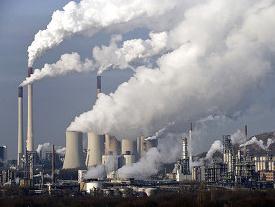 Setting The Record Straight On Climate Change: Experts Respond.
Setting The Record Straight On Climate Change: Experts Respond. Here is an Op-Ed that appears on
WSJ.com, a rebuttal to an Op-Ed from a group of climate skeptics a few days ago. This Op-Ed also appears on the blog,
Climate Communication: "
Do you consult your dentist on your heart condition? In science, as in any area, reputations are based on knowledge and expertise in a field, and on published, peer-reviewed work. If you need surgery, you want a highly experienced expert in the field who has done a large number of the proposed operations. On January 27, the Wall Street Journal published an op-ed on climate change by the climate science equivalent of dentists practicing cardiology. While accomplished in their own fields, most of these authors have no expertise in climate science. The few authors who have such expertise are known to have extreme views that are out of step with nearly every other climate expert. This happens in nearly every field of science. For example, there is a retrovirus expert who does not accept that HIV causes AIDS. And it is instructive to recall that a few scientists continued to state that smoking did not cause cancer, long after that was settled science. Climate experts know that the long-term warming trend has not abated in the past decade. In fact, it was the warmest decade on record. Observations show unequivocally that our planet is getting hotter."
